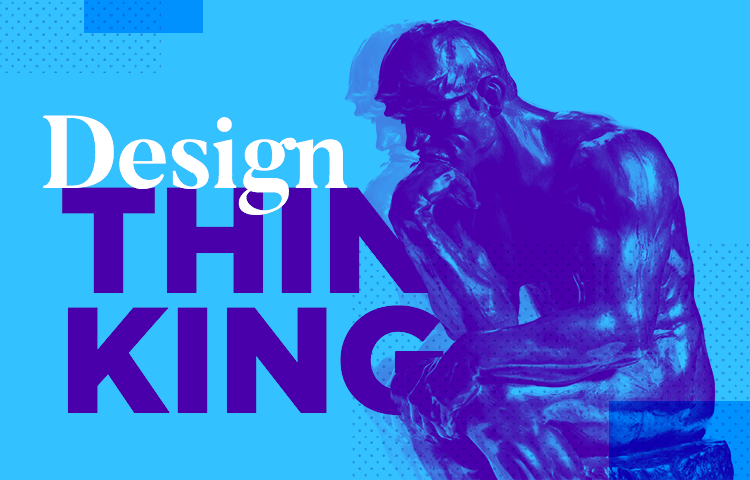The design thinking model has conquered designers and users everywhere - but how does it work? Here is a guide to put it all into perspective!
Design thinking has been around for a while now, and its popularity is still going strong. People from all sorts of professions trust this model to help them tackle complex issues, and achieve something that truly makes a difference – and consumers and users everywhere definitely appreciate that.
That’s the thing about great products. They aren’t just fun or pretty to look at, but they actually solve problems that users face – finding that problem and its solution is easier said than done, however. Thankfully, that’s what the design thinking model is here for: it gives you a sense of direction and pushes you towards innovation while using your prototyping tool.
Let’s take a closer look at why the model works to everyone’s advantage and how it manages to achieve that.
The design thinking method is a workflow that creative professionals can use for guidance during the creative process. By following certain steps and organizing tasks such as user research, designers can decrease the risk of getting lost in their search for the perfect product or the ideal market gap.
Not only that, but the model also helps designers to succeed in each step, because the methodology calls for designers to approach each stage in a certain way. Going back to the user research stage – designers aren’t expected to just list data and data on users until you can write a biography.
The real goal here is to understand the user so you can understand their struggles, to truly empathize with others.
The method was originally based on the H. A. Simon book by the name of The Sciences of the Artificial. Since then, it was evolved into the most commonly used version today which derives from the Hasso-Plattner Institute of Design at Stanford, a leading institution on the matter.
The design thinking methodology found the perfect home in UX design, for its user-centric orientation. UX designers all share the challenge of creating something for the user that combines both automated software and human-like communication – which can be a tough line to walk.
If that wasn’t reason enough for designers to at least give the model a shot, there is also the way the model is organized.
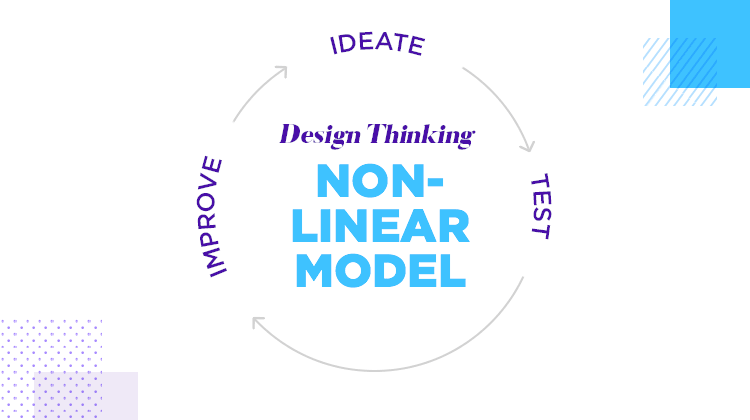
Contrary to other creative models, the design thinking model isn’t linear. In fact, it encourages designers to constantly test their ideas and reiterate on what can be improved. This can have massive consequences for UX designers, especially when working on a complex product, of which each feature needs to be tested, examined and improved several times over.
Hence, UX designers use design thinking to ensure they create something that is not only useful, but something that people can understand, relate to or even befriend. Designers also enjoy the way the model guides them through the key parts of the creative process, while not limiting their creativity at all. What’s not to love, right?
The classic design thinking process is divided into 5 stages. Each of them has its own goal within the creative process, and while none of them can be skipped or ignored, designers are welcome to leap back and forth from stage to stage. Check them out.

The equivalent to carrying out market research, the first stage of the design thinking model has the goal of understanding the user. This is when you’ll talk, watch and read about users and try to empathize with them, with the aim of seeing things through their eyes.
You want to find out any problems that users face frequently, things they need to find workarounds for – we all have those, without even noticing.

Logically, spotting those issues isn’t easy and requires quite an ability to place yourself in the user’s place. There are many ways and tactics you can use to achieve that – from focus groups to interviews.
This stage may seem simple enough, but it does come with some pitfalls. Setting out to understand people seems easy – but the real danger lies in your own mind. Designers are often tempted to draw conclusions from the data they have, assuming that to be enough to paint the whole picture.
Putting all you learned from stage one into practice, the definition stage calls for you to define what problem your product will try to solve. Here is where you want to make sure you understand what are the leading factors that cause the problem, along with the consequences the problem implies for users.
Contrary to what many believe, reiterating and going back to the definition of the problem is a good thing in the product development phase. The problem is the very reason your product exists – getting this wrong will, without a doubt, spell disaster. It’s always better to take what you learn on the other stages and make sure your definition of the problem is accurate. Trust us.
Designers everywhere unite with joy at this stage. Once you’ve got the people you’ll design for and which one of their problems you’ll solve, it’s then time to come up with solutions.
The design thinking model encourages you and your team to gather as many ideas as you can, without controlling or discriminating against unfeasible ideas – to maximize the creativity of everyone involved.

Once you have all the ideas you can come up with in one spot, it’s time to separate a few winners that will move on to the next phase. You want from 3-5 ideas, to allow plenty of room to change and adapt the ideas into something truly usable. Those selected ideas will become prototypes, which will then be put to the test.
The trick to making the most of your prototyping when applying the design thinking model is to get the winning ideas and turn them into low-fidelity prototypes – we recommend you make use of a prototyping tool from the get-go, so you develop and test prototypes as you advance.
As a general rule, the greater detail you apply to the prototype and the longer you work on it, the more expensive that prototype becomes.

Given that you’ll have a few ideas you’ll need to prototype, it’s better to get them done quickly and stick only to the crucial elements.
That will allow you to move through the ideas, so that all prototypes are cheap while still fulfilling their main use – to turn your ideas into something tangible. Something you can experience and test – which brings us to the last stage of the model.
This is the moment of truth. Giving users your product along with a list of tasks is the ultimate test of your idea. There are many techniques and different tactics for user testing your design, but let’s stick with the most basic, and most important, concept: you want to validate every feature of your design.
You don’t want to explain anything or share any details about the product with the users. You want to have their reaction be as truthful as possible, without any interference from you. Take note of their feelings, especially if you find that they look confused. Always ask open-ended questions and try to get users to elaborate on their answers.
Here at Justinmind, we have our own way of implementing the design thinking model. In our version, the testing stage is broken up into two: qualitative and quantitative testing. While this may seem like a rather small twist, it has massive implications on user testing, and the process of product development as a whole.
Spoiler alert: it’s all about applying the scientific method to your validation. Be sure to check it out on chapter one.
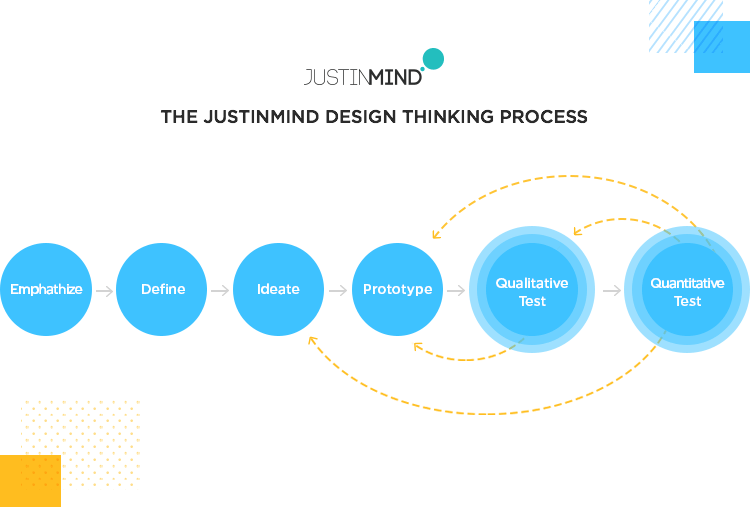
One of the most valuable skills any professional can have today is the willingness and desire to constantly learn. That is true of architects, developers, writers and it’s just as true of UX designers. While the design thinking model has a well-defined process, truly mastering it can be a challenge.
Unfortunately, following the stages is easier said than done, mainly because they require a certain mindset and don’t follow a linear flow- which can make the model a difficult concept to grasp and implement.
If you’re considering embarking on a learning journey that leads to a better informed version of yourself, you’ll definitely want to consider the books we’ve selected for you. Our list includes books that dig deep and offer plenty of real-life examples of concepts that challenge readers, such as the topic of empathy.
We offer readers 3 key books that approach the design thinking methodology, and will leave you with a good understanding of how the model works – and why it works. Check them out:
Tim Brown does a wonderful job at illustrating why great products don’t just pop out of the minds of creative people. Instead, Brown offers the explanation that great products are the result of a certain creative process – which is the key factor in designs that are truly innovative.
The book also has great insights into IDEO, itself an industry-established symbol of innovation. Did we mention Brown is IDEO’s CEO?
The message Ellen Lupton aims at passing on through this book is something that should concern all designers: creativity isn’t a gift some people are born with. It is, rather, a skill that we all need to polish and practice, and which improves over time.

The book also comes with several tactics to get your creativity going with real-life case studies that put it all into perspective. You’re bound to learn a thing or two about how you can improve your creative skills.
Design thinking is a compilation of many essays brought to the reader by different seasoned professionals that explore the many aspects and faces of the model. You’ll find personal stories of how the methodology had an impact on people’s work, along with specific personal tactics these professionals apply in their respective companies.
Sometimes, reading a book suffices. Sometimes, you just need someone to teach it to you in little steps. Granted, we can learn all sorts of things for free with a little help from the internet – but reading a book on astrophysics doesn’t translate to you becoming a physicist (unfortunately).
It’s perfectly fine to need someone to take the time to teach you a new concept – that’s why we, here at Justinmind, decided to bring you a comprehensive list that includes both online and in-classroom courses.
While some of them have different ultimate goals and focuses that differ slightly, all of these courses will improve your design skills – and give your curriculum a boost!
Here are the top 3 from our list.
This course brought to you by the iconic design agency IDEO is made up of two courses: “Insights of innovation” and “From ideas into action”. The certificate has the goal of boosting and fomenting innovation , with tutors engaging and fomenting debate surrounding what it is really means to innovate and to create.
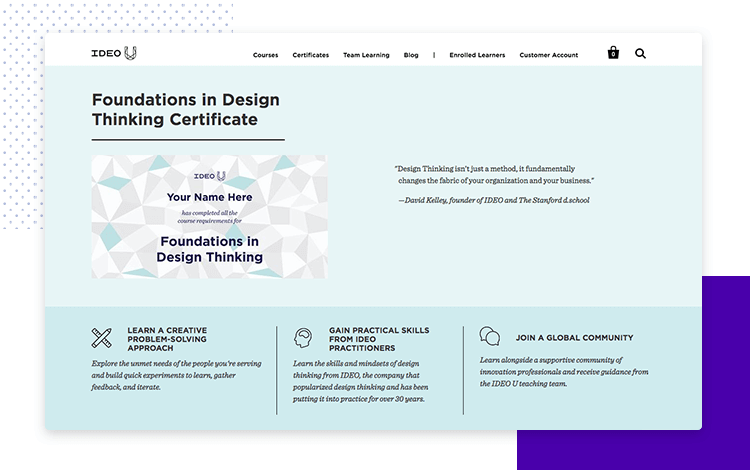
Take each course separately or combine them to achieve the certificate.
Where: online
Tuition: $798 for full certificate
Duration: approximately 2 months
See the official page
In the form of a MicroMasters program, this series of courses all count towards credits for a graduate education at the Rochester Institute of Technology. Given that is program has a more academic tone, it is also the longest course on our list – with a duration of about 30 weeks! Completion of all courses equates to 33 credits at RIT. Each course can also be taken individually.
Where: online
Tuition: $900 for program
Duration: 30 weeks total
See the official page
This self-paced design course is brought to you by the Interaction Design Foundation and is, as you might guess, aimed specifically at UX designers. The main focus of the course is getting students well-prepared to create better processes, better solutions, and as an outcome, better products.
Where: online
Tuition: IDF membership
Duration: 7 weeks
See the official page
Our list of the top tools for UX designers that want to implement the design thinking methodology to their work is all about taking the most of your time and effort. The model acts as a mental map for designers to help organize their efforts and channel their creativity – really, you can implement the model without any tool at all. But should you? That’s a different matter.

With the exception of the prototyping and testing stages, the methodology is quite simple. The model makes use of your human abilities such as the ability to feel empathy towards others, or the skill to identify and narrow down a problem others experience. Given that you can do all of those in your head, you might dismiss the idea of adding tools to the mix.
But like all other tasks, having the right tools at your disposal will get you to the finish line faster and more efficiently. Having a way to organize, develop and display your work as you advance in the model will push the quality of your work – while you worry only about crucial aspects of your project.
We sat down with Didier Chincholle, global UX lead at Ericsson, to talk about how design thinking is present across the creative process across the enterprise. As some of you may know, Ericsson is a swedish giant in the communications sector – the enterprise enjoys a market share of around 30%!
The company is also present in 200 countries around the globe, and has been around since the 1800s.
“If a picture is worth a thousand words, then a prototype is worth a thousand meetings”
Didier Chincholle - UX lead at Ericsson
Since being founded, Ericsson has come a long way. Among the keys to its success, is the fact that the company elevates design thinking and user experience, so that they become a central part of Ericsson’s business strategy. That’s what we heard from Chincholle, who provided us with precious insight into how Ericsson manages to apply the model at such a large scale.
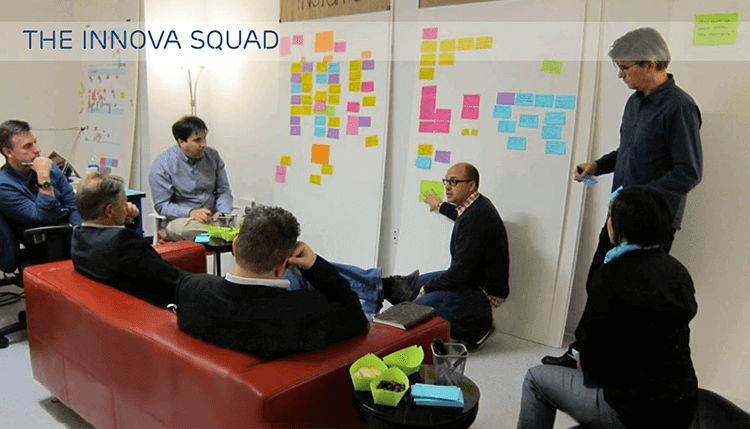
Spoiler alert: it’s all about establishing a UX framework across different business units. Things like specific roles and guidelines are key in getting different teams to work together effectively.
From the importance of setting up diverse teams and establishing a shared vision, Chincholle led on just how much of an impact the design thinking approach has had on the products Ericsson designs. Among the most valuable wisdom Chincholle shared with us, is the role prototyping plays in the creative process and strategy at Ericsson.
“Touching, interacting and experiencing interfaces is key to selling concepts”
Didier Chincholle - UX lead at Ericsson
Read all about the role prototyping plays within Ericsson and how design thinking impacts their product development on chapter 5.
IBM needs no introduction – the information technology giant is present in over 170 countries and we’ve all heard of it. We were super excited to talk to Doug Powell, distinguished designer at IBM, and have him spill the beans on the inner workings of IBM.
Among the topics that we explored during our talk with Doug, you’ll find not only some great insights into IBM’s design program, but also some wisdom regarding the challenges design teams everywhere face.
“The ‘user’ of yesterday was a deeply technical expert, someone whose entire career was built around running a particular system. But what we’re finding now is that the teams we’re designing for are much more complex than they used to be.”
Doug Powell - Designer at IBM
As time passes, it’s only normal that things change – but how have they changed for product designers? What about large design teams? Here’s a little hint, in the form of a quote from the man himself.
In the interview, it became clear that design thinking was a methodology IBM takes very seriously. Aside from discussing why the model is of great importance to the enterprise, Powell did a wonderful job in explaining the challenges they faced when trying to implement it.
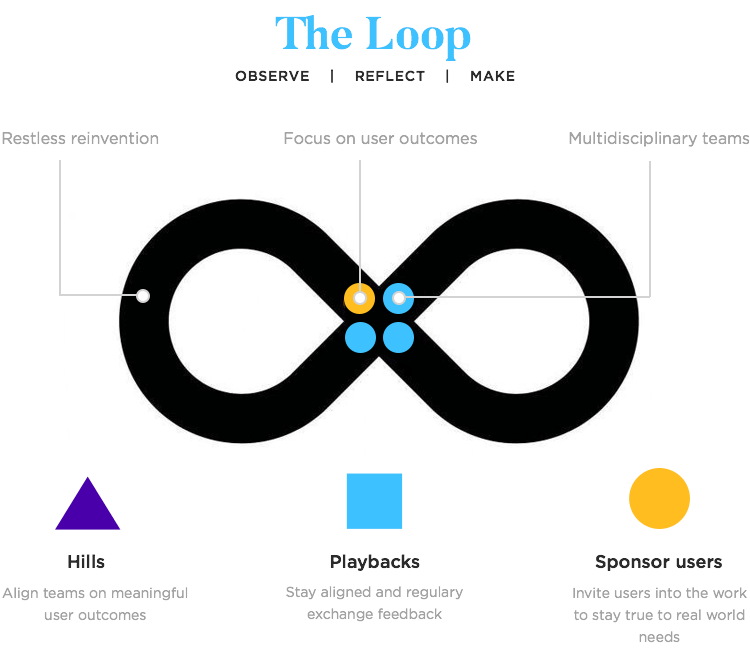
But here is what we loved about Doug’s explanation: the very thing that made it difficult for teams to work efficiently, later became a factor that forced a better workflow to emerge. And it does make sense. Implementing anything across in a team that stretches across the globe is difficult, as parts of the team won’t even be awake during your working hours.
“Not just prototyping, but prototyping at as low a fidelity as you can, as early as you can.”
Doug Powell - Designer at IBM
But how did IBM use that very fact, along with the design thinking method, to turn their weakness into a source of strength? You’re better off hearing from Doug Powell himself! Catch his interview in chapter 6.
There isn’t any doubt that the design thinking model has had a huge impact in the design industry – possibly even more so when it comes to UX design. Be it to ensure you have the right group of users in mind or that your product will prove useful to people – or just to make sure you don’t lose your way, the model has its uses.
The model has proved to be a huge help to design teams everywhere – perhaps now is the time for you to give it a try too!
